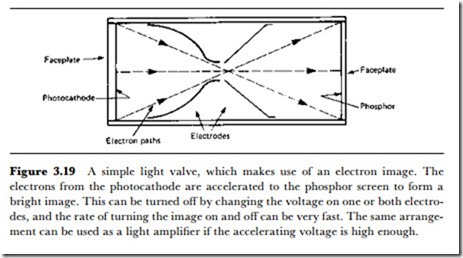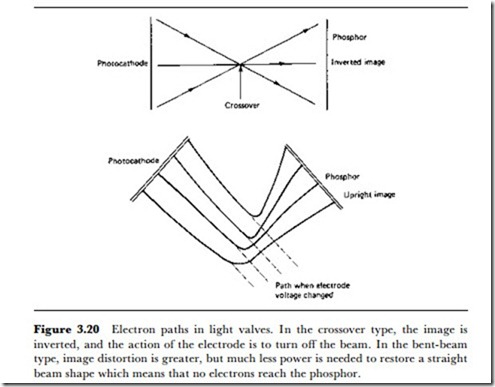Light valves
A Light vaLve is a device that is the electronic equivalent of a camera shutter. The LCD is one form of light valve, but the term is generally reserved for very high-speed devices that are capable of nanosecond timing. Light valves of this specialized type are used for ultra-high-speed photography, particularly for the photography of explosions and very fast chemical or nuclear reactions. The device is, like the LCD, a light modulator rather than a transducer, but some mention is due here.
The original type of light valve was a spin-off from TV camera techniques, and relied on the use of an electron beam. The principle is illustrated in Figure 3.19, with a photocathode at one end of an evacuated tube and a screen at the other. With a suitable accelerating voltage between the photo- cathode and the screen, and possibly a magnetic field applied to maintain focus, the image on the photocathode can also be obtained on the screen. The electrodes near the photocathode can affect the electron beam, usually by deflecting it so that it does not reach the screen. This is most easily done if the beam is allowed to cross over or follow a bowed path (Figure 3.20) on its way from the photocathode to the screen. High-speed electronic shutters of this type have been used to photograph events in nuclear explosions and are used extensively to analyse actions such as flame propagation in cylinder heads of car engines and in the ignition tubes of gas turbines.
The principle of photocathode and phosphor screen can also be used in image intensijiers. By using a large accelerating voltage between the photo- cathode and the screen, the light energy from the screen can greatly exceed the intensity reaching the photocathode. There can also be frequency con- version, because the photocathode can be an infrared-sensitive type and the screen a normal white one, allowing images to be seen in apparent darkness. This principle was used in World War II as a gunner’s night
sight, and has been considerably refined since then in terms of sensitivity, size and power consumption, and clarity of image.
Another well-established form of light switch is the Kerr ceLL. The Kerr cell uses an effect similar to the LCD – the effect of an electric field to rotate the plane of polarized light in a transparent material. Early types of Kerr cells used liquid suspensions, but later types have been able to use solid crystals. One application of modern Kerr cells has been to modulate laser light, allowing large-screen colour TV displays to be obtained from three laser beams. Another old-established effect, the Faraday effect, is used to deflect the light beams.

